findchangepts
Find abrupt changes in signal
Syntax
Description
ipt = findchangepts(x)x changes most significantly.
If
xis a vector with N elements, thenfindchangeptspartitionsxinto two regions,x(1:ipt-1)andx(ipt:N), that minimize the sum of the residual (squared) error of each region from its local mean.If
xis an M-by-N matrix, thenfindchangeptspartitionsxinto two regions,x(1:M,1:ipt-1)andx(1:M,ipt:N), returning the column index that minimizes the sum of the residual error of each region from its local M-dimensional mean.
ipt = findchangepts(x,Name,Value)
findchangepts(___) without output arguments plots
the signal and any detected changepoints. For more information, see Statistic.
Note
Before plotting, the findchangepts function clears (clf) the current figure. To plot the signal
and detected changepoints in a subplot, use a plotting function. See Audio File Segmentation.
Examples
Load a data file containing a recording of a train whistle sampled at 8192 Hz. Find the 10 points at which the root-mean-square level of the signal changes most significantly.
load train findchangepts(y,MaxNumChanges=10,Statistic="rms")
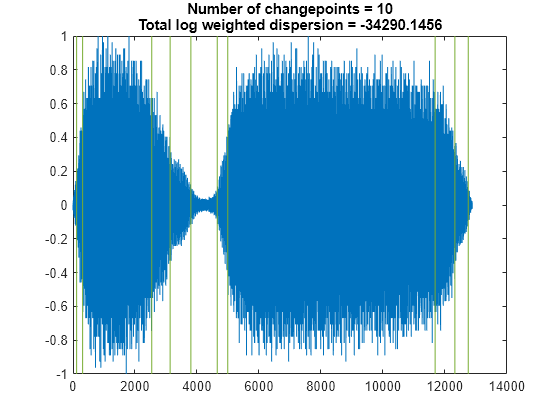
Compute the short-time power spectral density of the signal. Divide the signal into 128-sample segments and window each segment with a Hamming window. Specify 120 samples of overlap between adjoining segments and 128 DFT points. Find the 10 points at which the mean of the power spectral density changes the most significantly.
[s,f,t,pxx] = spectrogram(y,128,120,128,Fs); findchangepts(pow2db(pxx),MaxNumChanges=10)
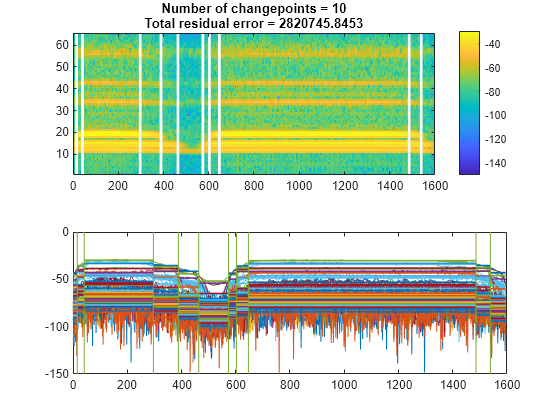
Reset the random number generator for reproducible results. Generate a random signal where:
The mean is constant in each of seven regions and changes abruptly from region to region.
The variance is constant in each of five regions and changes abruptly from region to region.
rng("default")
lr = 20;
mns = [0 1 4 -5 2 0 1];
nm = length(mns);
vrs = [1 4 6 1 3];
nv = length(vrs);
v = randn(1,lr*nm*nv)/2;
f = reshape(repmat(mns,lr*nv,1),1,lr*nm*nv);
y = reshape(repmat(vrs,lr*nm,1),1,lr*nm*nv);
t = v.*y+f;Plot the signal, highlighting the steps of its construction.
subplot(2,2,1) plot(v) title("Original") xlim([0 700]) subplot(2,2,2) plot([f;v+f]') title("Means") xlim([0 700]) subplot(2,2,3) plot([y;v.*y]') title("Variances") xlim([0 700]) subplot(2,2,4) plot(t) title("Final") xlim([0 700])
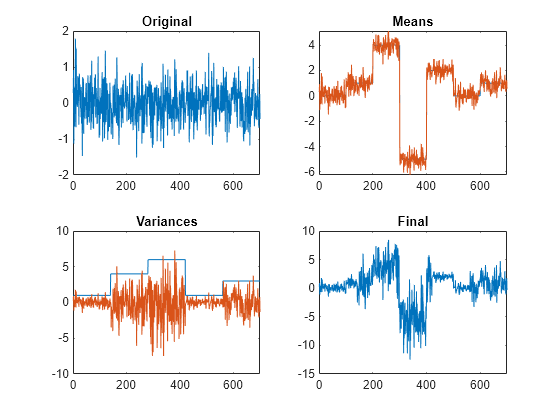
Find the five points where the mean of the signal changes most significantly.
figure findchangepts(t,MaxNumChanges=5)
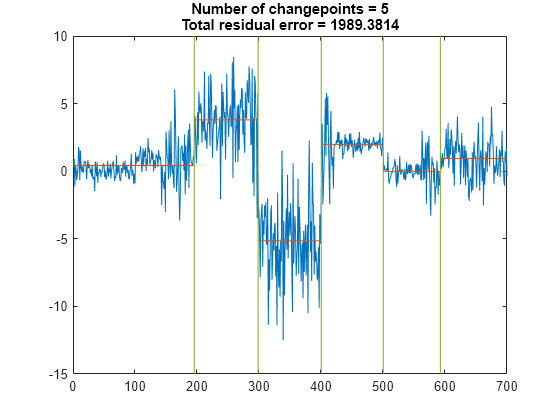
Find the five points where the root-mean-square level of the signal changes most significantly.
findchangepts(t,MaxNumChanges=5,Statistic="rms")
Find the point where the mean and standard deviation of the signal change the most.
findchangepts(t,Statistic="std")
Load a speech signal sampled at . The file contains a recording of a female voice saying the word "MATLAB®."
load mtlbDiscern the vowels and consonants in the word by finding the points at which the variance of the signal changes significantly. Limit the number of changepoints to five.
numc = 5;
[q,r] = findchangepts(mtlb,Statistic="rms",MaxNumChanges=numc);Create a signal mask for the speech signal based on the changepoint indices. See signalMask for more information about using a signal mask.
t = (0:length(mtlb)-1)/Fs; roitable = ([[1;q] [q;length(mtlb)]]); x = ["M" "A" "T" "L" "A" "B"]'; c = categorical(x,unique(x,"stable")); msk = signalMask(table(t(roitable),c),SampleRate=Fs,RightShortening=1); roimask(msk)
ans=6×2 table
Var1 c
___________________ _
0 0.017525 M
0.01766 0.10461 A
0.10475 0.22162 T
0.22176 0.33675 L
0.33688 0.46535 A
0.46549 0.53909 B
Plot the speech signal and detected changepoints in a subplot along with the regions of interest from the signal mask:
In the upper subplot, use the
plotsigroifunction to visualize the signal mask regions. Adjust the settings to make the colorbar appear at the top..In the lower subplot, plot the original speech signal and add the detected changepoints as vertical lines.
subplot(2,1,1) plotsigroi(msk,mtlb) colorbar("off") nc = numel(c)-1; colormap(gca,lines(nc)); colorbar(TickLabels=categories(c),Ticks=1/2/nc:1/nc:1, ... TickLength=0,Location="northoutside") xlabel("") subplot(2,1,2) plot(t,mtlb) hold on xline(q/Fs) hold off xlim([0 t(end)]) xlabel("Seconds")
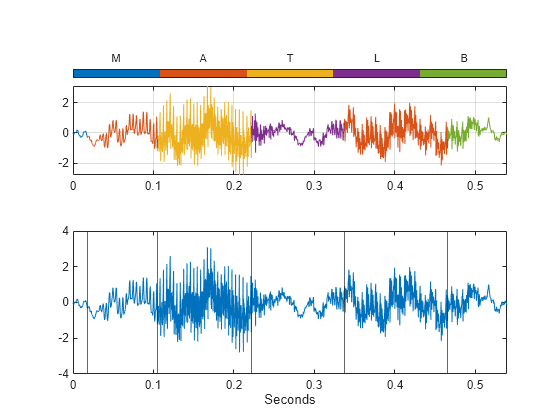
To play the sound with a pause after each of the segments, uncomment these lines.
% for k = 1:length(roitable) % intv = roitable(k,1):roitable(k,2); % soundsc(mtlb(intv).*hann(length(intv)),Fs) % pause(.5) % end
Create a signal that consists of two sinusoids with varying amplitude and a linear trend.
vc = sin(2*pi*(0:201)/17).*sin(2*pi*(0:201)/19).* ...
[sqrt(0:0.01:1) (1:-0.01:0).^2]+(0:201)/401;Find the points where the signal mean changes most significantly. The 'Statistic' name-value argument is optional in this case. Specify a minimum residual error improvement of 1.
findchangepts(vc,'Statistic','mean','MinThreshold',1)
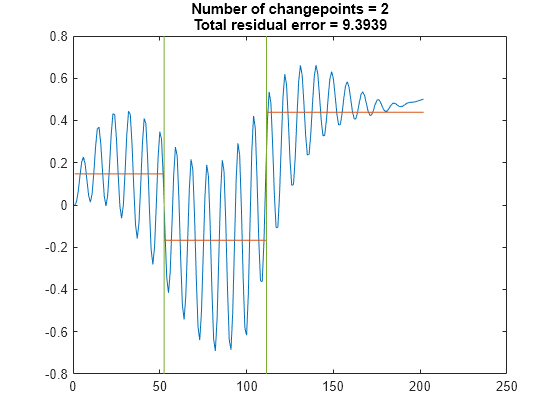
Find the points where the root-mean-square level of the signal changes the most. Specify a minimum residual error improvement of 6.
findchangepts(vc,'Statistic','rms','MinThreshold',6)
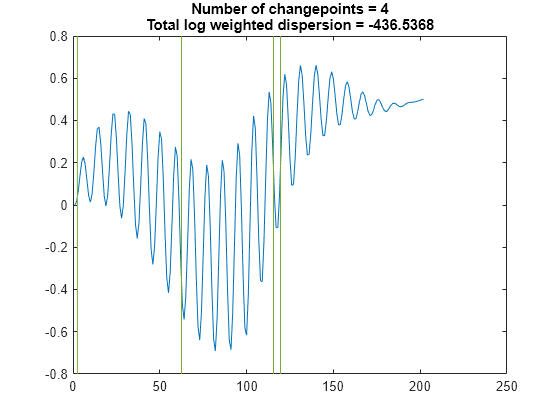
Find the points where the standard deviation of the signal changes most significantly. Specify a minimum residual error improvement of 10.
findchangepts(vc,'Statistic','std','MinThreshold',10)
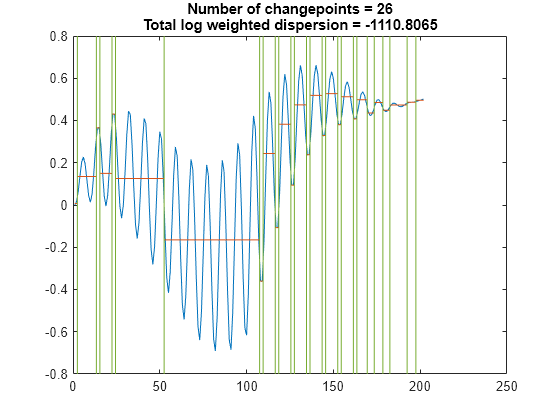
Find the points where the mean and the slope of the signal change most abruptly. Specify a minimum residual error improvement of 0.6.
findchangepts(vc,'Statistic','linear','MinThreshold',0.6)

Generate a two-dimensional, 1000-sample Bézier curve with 20 random control points. A Bézier curve is defined by:
,
where is the th of control points, ranges from 0 to 1, and is a binomial coefficient. Plot the curve and the control points.
m = 20;
P = randn(m,2);
t = linspace(0,1,1000)';
pol = t.^(0:m-1).*(1-t).^(m-1:-1:0);
bin = gamma(m)./gamma(1:m)./gamma(m:-1:1);
crv = bin.*pol*P;
plot(crv(:,1),crv(:,2),P(:,1),P(:,2),"o:")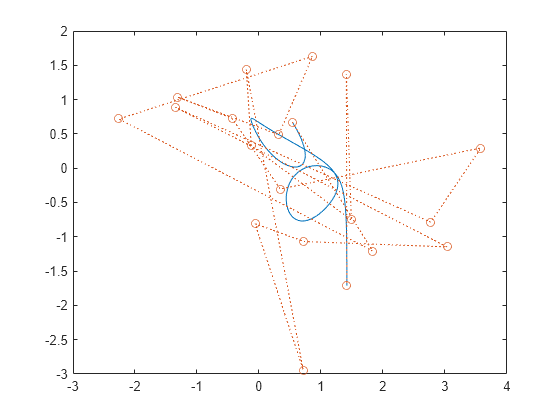
Partition the curve into three segments, such that the points in each segment are at a minimum distance from the segment mean.
findchangepts(crv',MaxNumChanges=3)
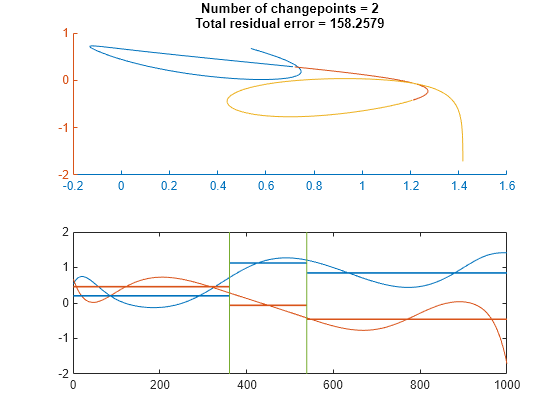
Partition the curve into 20 segments that are best fit by straight lines.
findchangepts(crv',Statistic="linear",MaxNumChanges=19)
Generate and plot a three-dimensional Bézier curve with 20 random control points.
P = rand(m,3); crv = bin.*pol*P; plot3(crv(:,1),crv(:,2),crv(:,3),P(:,1),P(:,2),P(:,3),"o:") xlabel("x") ylabel("y")
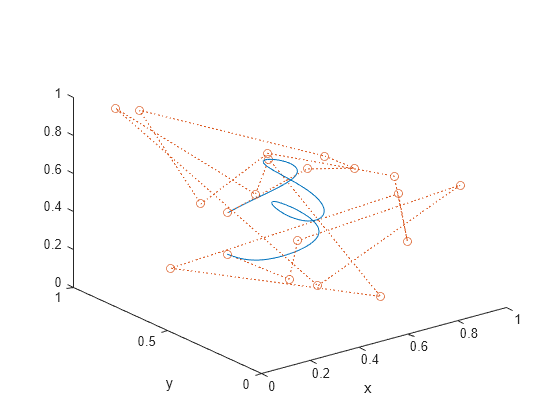
Visualize the curve from above.
view([0 0 1])
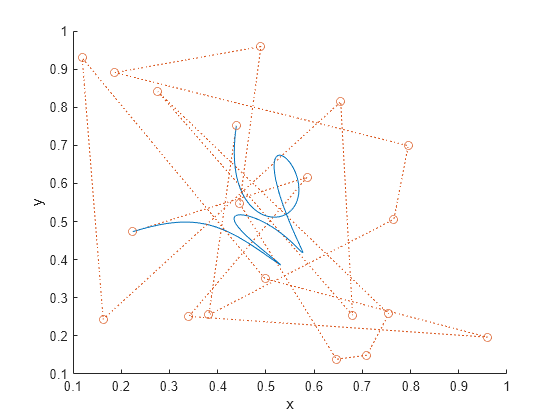
Partition the curve into three segments, such that the points in each segment are at a minimum distance from the segment mean.
findchangepts(crv',MaxNumChanges=3)
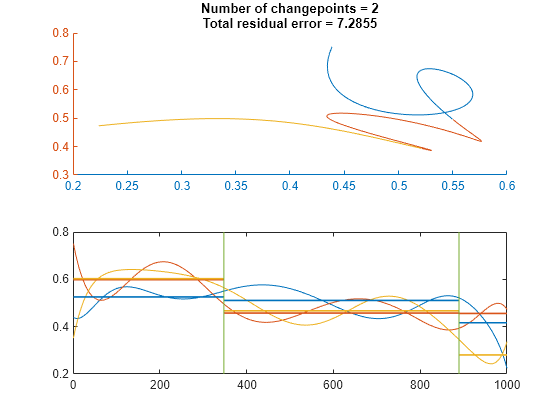
Partition the curve into 20 segments that are best fit by straight lines.
findchangepts(crv',Statistic="linear",MaxNumChanges=19)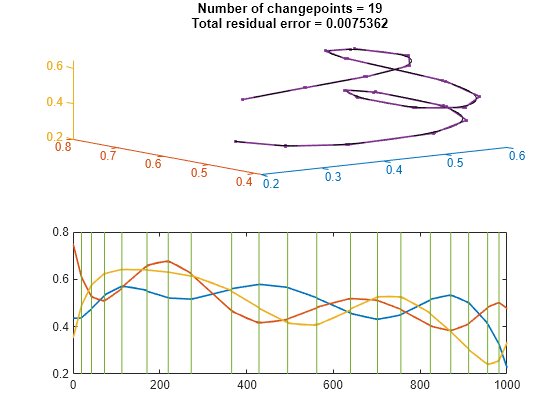
Input Arguments
Input signal, specified as a real-valued vector or matrix.
If
xis a vector with N elements, thenfindchangeptspartitionsxinto two regions,x(1:ipt-1)andx(ipt:N), that minimize the sum of the residual (squared) error of each region from the local value of the statistic specified inStatistic.If
xis an M-by-N matrix, thenfindchangeptspartitionsxinto two regions,x(1:M,1:ipt-1)andx(1:M,ipt:N), returning the column index that minimizes the sum of the residual error of each region from the local M-dimensional value of the statistic specified inStatistic.
Example: reshape(randn(100,3)+[-3 0 3],1,300) is
a random signal with two abrupt changes in mean.
Example: reshape(randn(100,3).*[1 20 5],1,300) is
a random signal with two abrupt changes in root-mean-square level.
Data Types: single | double
Name-Value Arguments
Specify optional pairs of arguments as
Name1=Value1,...,NameN=ValueN, where Name is
the argument name and Value is the corresponding value.
Name-value arguments must appear after other arguments, but the order of the
pairs does not matter.
Example: MaxNumChanges=3,Statistic="rms",MinDistance=20 finds up to
three points where the changes in root-mean-square level are most significant and where
the points are separated by at least 20 samples.
Before R2021a, use commas to separate each name and value, and enclose
Name in quotes.
Example: 'MaxNumChanges',3,'Statistic',"rms",'MinDistance',20 finds up to
three points where the changes in root-mean-square level are most significant and where
the points are separated by at least 20 samples.
Maximum number of significant changes to return, specified as an integer scalar. After finding
the point with the most significant change, findchangepts
gradually loosens its search criterion to include more changepoints without
exceeding the specified maximum. If any search setting returns more than the
maximum, then the function returns nothing. If MaxNumChanges
is not specified, then the function returns the point with the most significant
change. You cannot specify MinThreshold and
MaxNumChanges simultaneously.
Example: findchangepts([0 1 0]) returns the
index of the second sample.
Example: findchangepts([0 1 0],MaxNumChanges=1) returns an empty
matrix.
Example: findchangepts([0 1 0],MaxNumChanges=2) returns the indices of the
second and third points.
Data Types: single | double
Type of change to detect, specified as one of these values:
"mean"— Detect changes in mean. If you callfindchangeptswith no output arguments, the function plots the signal, the changepoints, and the mean value of each segment enclosed by consecutive changepoints."rms"— Detect changes in root-mean-square level. If you callfindchangeptswith no output arguments, the function plots the signal and the changepoints."std"— Detect changes in standard deviation, using Gaussian log-likelihood. If you callfindchangeptswith no output arguments, the function plots the signal, the changepoints, and the mean value of each segment enclosed by consecutive changepoints."linear"— Detect changes in mean and slope. If you callfindchangeptswith no output arguments, the function plots the signal, the changepoints, and the line that best fits each portion of the signal enclosed by consecutive changepoints.
Example: findchangepts([0 1 2 1],Statistic="mean") returns the index of the
second sample.
Example: findchangepts([0 1 2 1],Statistic="rms") returns the index of the
third sample.
Minimum number of samples between changepoints, specified as an integer scalar. If you do not specify this number, then the default is 1 for changes in mean and 2 for other changes.
Example: findchangepts(sin(2*pi*(0:10)/5),MaxNumChanges=5,MinDistance=1)
returns five indices.
Example: findchangepts(sin(2*pi*(0:10)/5),MaxNumChanges=5,MinDistance=3)
returns two indices.
Example: findchangepts(sin(2*pi*(0:10)/5),MaxNumChanges=5,MinDistance=5)
returns no indices.
Data Types: single | double
Minimum improvement in total residual error for each changepoint, specified as a real scalar
that represents a penalty. This option acts to limit the number of returned
significant changes by applying the additional penalty to each prospective
changepoint. You cannot specify MinThreshold and
MaxNumChanges simultaneously.
Example: findchangepts([0 1 2],MinThreshold=0) returns two
indices.
Example: findchangepts([0 1 2],MinThreshold=1) returns one
index.
Example: findchangepts([0 1 2],MinThreshold=2) returns no
indices.
Data Types: single | double
Output Arguments
Changepoint locations, returned as a vector of integer indices.
Residual error of the signal against the modeled changes, returned as a vector.
More About
A changepoint is a sample or time instant at which some statistical property of a signal changes abruptly. The property in question can be the mean of the signal, its variance, or a spectral characteristic, among others.
To find a signal changepoint, findchangepts employs a parametric
global method. The function:
Chooses a point and divides the signal into two sections.
Computes an empirical estimate of the desired statistical property for each section.
At each point within a section, measures how much the property deviates from the empirical estimate. Adds the deviations for all points.
Adds the deviations section-to-section to find the total residual error.
Varies the location of the division point until the total residual error attains a minimum.
The procedure is clearest when the chosen statistic is the mean. In that case,
findchangepts minimizes the total residual error from the "best"
horizontal level for each section. Given a signal x1,
x2, …,
xN, and the subsequence mean and variance
where the sum of squares
findchangepts finds k such
that the total residual error
is smallest. This result can be generalized to incorporate other
statistics. findchangepts finds k such that the
total residual error
is smallest, given the section empirical estimate χ and the deviation measurement Δ.
Minimizing the residual error is equivalent to maximizing the log likelihood. Given a normal distribution with mean μ and variance σ2, the log-likelihood for N independent observations is
If
Statisticis specified as"mean", the variance is fixed and the function usesas obtained previously.
If
Statisticis specified as"std", the mean is fixed and the function usesIf
Statisticis specified as"rms", the total deviation is the same as for"std"but with the mean set to zero:If
Statisticis specified as"linear", the function uses as total deviation the sum of squared differences between the signal values and the predictions of the least-squares linear fit through the values. This quantity is also known as the error sum of squares, or SSE. The best-fit line through xm, xm+1, …, xn isand the SSE is
Signals of interest often have more than one changepoint. Generalizing the procedure
is straightforward when the number of changepoints is known. When the number is unknown,
you must add a penalty term to the residual error, since adding changepoints always
decreases the residual error and results in overfitting. In the extreme case, every
point becomes a changepoint and the residual error vanishes.
findchangepts uses a penalty term that grows linearly with the
number of changepoints. If there are K changepoints to be found, then
the function minimizes
where k0 and kK are respectively the first and the last sample of the signal.
The proportionality constant, denoted by β and specified in
MinThreshold, corresponds to a fixed penalty added for each changepoint.findchangeptsrejects adding additional changepoints if the decrease in residual error does not meet the threshold. SetMinThresholdto zero to return all possible changes.If you do not know what threshold to use or have a rough idea of the number of changepoints in the signal, specify
MaxNumChangesinstead. This option gradually increases the threshold until the function finds fewer changes than the specified value.
To perform the minimization itself, findchangepts uses an
exhaustive algorithm based on dynamic programming with early abandonment.
References
[1] Killick, Rebecca, Paul Fearnhead, and Idris A. Eckley. “Optimal detection of changepoints with a linear computational cost.” Journal of the American Statistical Association. Vol. 107, No. 500, 2012, pp. 1590–1598.
[2] Lavielle, Marc. “Using penalized contrasts for the change-point problem.” Signal Processing. Vol. 85, August 2005, pp. 1501–1510.
Extended Capabilities
Usage notes and limitations:
If you specify input argument
Statistic, then it must be a compile-time constant.
Version History
Introduced in R2016a
MATLAB Command
You clicked a link that corresponds to this MATLAB command:
Run the command by entering it in the MATLAB Command Window. Web browsers do not support MATLAB commands.
Select a Web Site
Choose a web site to get translated content where available and see local events and offers. Based on your location, we recommend that you select: .
You can also select a web site from the following list
How to Get Best Site Performance
Select the China site (in Chinese or English) for best site performance. Other MathWorks country sites are not optimized for visits from your location.
Americas
- América Latina (Español)
- Canada (English)
- United States (English)
Europe
- Belgium (English)
- Denmark (English)
- Deutschland (Deutsch)
- España (Español)
- Finland (English)
- France (Français)
- Ireland (English)
- Italia (Italiano)
- Luxembourg (English)
- Netherlands (English)
- Norway (English)
- Österreich (Deutsch)
- Portugal (English)
- Sweden (English)
- Switzerland
- United Kingdom (English)